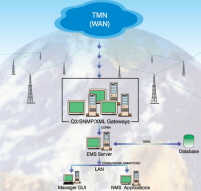|
PW
EMS (Element
Management System)
An Element Management System (EMS) manages one or more of a specific type of telecommunications network element (NE). Typically, the EMS manages the functions and capabilities within each NE such as Fault, Configuration, Accounting, Performance and Security (FCAPS). The EMS provides the foundation to implement TMN–layered operations support system (OSS) architectures that enable service providers to meet customer needs for rapid deployment of new services, as well as meeting stringent quality of service (QoS) requirements.
Packetware EMS is a TMN tool that provides a standardized EMS under TMN environment for managing various telecommunication network equipments such as SONET/SDH devices. It currently supports Fault, Performance and Configuration Management functions.
The Packetware EMS is fully compliant with the international TMN standards. The users of Packetware EMS include OMC (Operations & Maintenance Center) personnel, NMS (Network Management System) applications and Trouble Ticketing System applications.
Interoperability
Interoperability tests with a variety of network
elements is part of the Quality Assurance
process. The company is working with our clients to
continually expand the list of supported network
elements.
PW
EMS has been successfully interfaced to a number of network
elements using protocols like Q3 and proprietary
messaging over TCPIP.
Architecture
The
architecture of PW EMS is given below.

Packetware EMS has a centralized network manager and a number of
OSI/Q3 gateways, both collectively providing real-time monitoring and control. Further, it comes with an easy-to-use Windows client Graphical User Interface that provides full visibility into the network such as faults, performance graphs, etc., thus enabling network operators to prevent problems before they occur.
Packetware EMS provides a comprehensive and easy-to-use unified management interfaces to applications.
Features
and Functions
-
Basic
Features
-
Capture alarms/events emitted by network elements
-
Process alarms/events (such an alarm correlation)
-
Store them into database for user actions such as viewing, acknowledging and assigning trouble-tickets
-
Scheduled and interactive collection of 15-minutes performance data
-
Scheduled and interactive collection of 24-hours performance data
-
Scheduled and interactive collection of RSL (Received Signal Level) performance data
-
Advanced
features
-
Four tier architecture for modular & extensibility; there is a centralized server for managing all network elements in the network through one or more OSI/Q3 gateway machines. User interface GUIs connect to centralized server while back-office applications (such as trouble-ticketing system) connect to central database
-
Centralized configuration management (configuration of all network elements, network topology maps, etc., exists with centralized EMS Server)
-
Centralized data (Alarms & PM Data) management (data from all network elements is stored in a persistent RDBMS database such as Oracle). User queries are possible on data stored in database using standard SQL-92 commands
-
A single, distributed user-interface (GUI) for all operations such as configuration management, data monitoring cum management, etc, such as creating a new network element, viewing alarms, acknowledging alarms, viewing PM data, changing times etc.
-
GUI shows last event-received timestamp for each network element. This status information helps operator determine if NE is generating events/alarms regularly and as expected.
-
Interfaces
towards Network Elements
-
Interface
towards Applications
-
ODBC,
Q3, CORBA
(TMF 814), XML, SMNP
-
GUI
Features
-
Sub-net map based
displays
-
Logical view of data and sorting
-
Search by type/event
-
Display history information
-
Graphical & text based displays
-
Scalability/High
Availability
-
Scalable horizontally and vertically
-
High available platform support
-
Auto failover
-
Complete database support
-
Logging/Reports
-
System
Requirement
-
Can work on UNIX, NT and Linux platforms.
Available as highly available cluster platform also.
-
Hardware sizing depends on
Number of network elements
Number of interfaces
-
Standards
-
Conformant to all the following International ISO/TMN standards
X.700, X.711, X.721, X.733
Q.811, Q.812, Q.821, Q.822
M.3000, M.3010, M.3100, M.3200, M.3400
G.774 series
|
